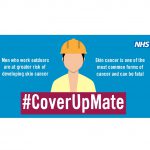 MEN in East Sussex are being urged to cover up this summer and reduce their risk of developing skin cancer.
MEN in East Sussex are being urged to cover up this summer and reduce their risk of developing skin cancer.
Cases of potentially fatal malignant melanoma, the most serious form of the disease, have more than doubled in the county since 2006 and rates are rising faster in men than women.
East Sussex County Council’s public health team is backing the national ‘Cover Up Mate’ campaign, which urges men to protect themselves from the sun.
The campaign targets men who work outdoors, who are at greatest risk of skin cancer but are often reluctant to take the simple steps which can drastically reduce their risk.
Cynthia Lyons, East Sussex acting director of public health, said: “Cases of malignant melanoma are rising faster among men than women, but men are often worse than their female counterparts at protecting themselves from the sun.
“Outdoor workers such as farmers or those working in the construction industry often just want to get on with the job, but they may end up paying the penalty for not taking this issue seriously.
“A sun tan is a sign of damage to the skin, not of health, and sunburn increases the risk of developing skin cancer later in life.
“Men owe it to themselves and their families to ensure they take the simple steps which can protect them from the sun and reduce their risk of this potentially fatal disease.”
People with fair skin, moles, freckles, red or fair hair or light coloured eyes are most prone to skin cancer. The months of May to September, when ultraviolet (UV) rays are highest, are the period of greatest risk and people can still burn even on cool days.
Anyone spending time outdoors is urged to stay in the shade where possible, make sure they never burn and protect themselves by wearing suitable clothing, sunglasses and sunscreen of at least factor 15, which should be reapplied every few hours.
People should regularly check their moles and visit their GP as soon as possible if they notice any mole or freckle changing size or shape.
More information on sun safety is available on the NHS Choices website
In 2014, the most recent year for which data is available, 194 cases of malignant melanoma were diagnosed in East Sussex – more than double the rate in 2006 when there were 94 cases – while deaths from this disease rose in the same time period by 35 per cent in the south east.
Rates of the disease in East Sussex are around 20 per cent higher than the England average, with Lewes district having the highest rate in East Sussex.
In East Sussex and nationally, skin cancer rates are rising faster in men than women. In younger adults, rates are higher in women, but this trend is reversed with ageing and in older adults rates are substantially higher among men.


